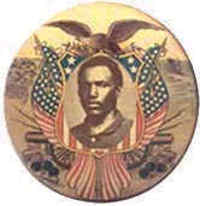Missouri’s Gallant 62nd
During the Civil War, 186,000 ex-slaves and black freedmen joined the Union Army. Thirty-seven thousand of them would not see the beginning of the new society. Amongst these men of war was a regiment of veteran black Missouri troops who took part in what is widely recognized as the final battle of the war.
In November of 1863 the State of Missouri created its first African-American regiment, the First Missouri Infantry Regiment, Colored. Enrolled and trained at Benton Barracks in St. Louis, the unit was re-designated the 62nd Regiment United States Colored Troops. The 62nd was to play a major role in the “The Battle of Palmetto Ranch”, on May 12-13, 1865. This battle, fought near Brownsville, Texas, is considered the final ground battle of the Civil War. Another name for the battle is “Palmetto Hill”; other spellings: Palmitto, Palmito. The story of the Battle of Palmetto Ranch follows:
One month after Robert E. Lee surrendered his Confederate Army in Virginia, a gentleman’s agreement was struck to forgo fighting between Union and Confederate forces on the Rio Grande. Despite the agreement, Col. Barrett, commanding forces at Brazos Santiago, Texas, dispatched 250 men of the 62nd Regiment U.S. Colored Infantry and 50 men of the 2nd Texas Cavalry Regiment (dismounted) to attack Rebel outposts and camps. Lt. Col. David Branson was in command. Col. Barrett’s excuse for the attack was to procure horses and supplies for his men. Other sources speculated his goal as a young officer was to achieve a measure of glory before hostilities ended.
Col. Branson’s force surrounded a suspected outpost at White’s Ranch, but found it empty. Mexican nationals on the far bank of the Rio Grande discovered his forces and spread the alarm to the Confederates. Col. Branson immediately attacked George Roberson’s Confederate camp at Palmetto Ranch, forcing Roberson to retreat. His company counterattacked, forcing Branson to order a retreat to White’s Ranch. Col. Barrett arrived on the 13th with 250 men of the 34th Indiana Volunteer Infantry. He took command and fought to a point a few miles past Palmetto Ranch.
Confederate Col. John S. “Rip” Ford, in command of Confederate forces, arrived with Anderson’s Battalion of cavalry, six 12 pound cannons, and 300 men from numerous other units including Gidding’s Regiment. The die had been cast. Cannon fire ripped the Union lines, and Confederate soldiers were close to breaking through. At one point, Col. Barrett, realizing he was out-flanked, ordered two detachments of the 34th Indiana Volunteer Infantry to cover his flanks.
As the battle raged, Col. Barrett and his men were compelled to make a final retreat. The 62nd was ordered to hold its positions at all costs and cover the retreat. In the confusion of battle the two detachments on his flank were not informed of the retreat and were captured. Though out-gunned and out-manned, the 62nd stood firm against the barrage of cannon fire, the onslaught of infantrymen and the repeated cavalry attacks.
After three hours of fighting, orders came to disengage. At 8 p.m. the 62nd arrived at Boca Chica. On May 14 at 4 a.m. they embarked for Brazos Santiago. The performance of the 62nd drew praise from Col. Barrett, who said, “Every attempt of the enemy’s cavalry to break this line was repulsed with loss to him, and the entire regiment fell back with precision and in perfect order, under circumstances that would have tested the discipline of the best troops.”
At Palmetto Ranch, when Missouri’s 62nd covered Barrett’s retreat it fired the last volley of the Civil War. Pvt. John J. Williams of the 34th Indiana is most often considered the last man to die in battle. He died on the field. Weeks later, however, Missouri resident private Bill Redman of the 62nd died of wounds received at Palmetto Ranch. Missouri’s Bill Redman therefore may lay claim to the distinction of being the last battle casualty of the Civil War to die as an immediate result of his wounds.
As men of courage and conviction, the men of the 62nd showed they were willing to die for their country, their honor and for their belief in the future of their race.
Copyright 2002 Stanford L. Davis, All Rights Reserved Stanford L. Davis is the author and Webmaster of www.buffalosoldier.net. His grandfather, Sgt. Anderson Davis of the 62nd (above), and great-grandfather served in the Civil War. Later, his great-grandfather served in the Indian Wars as a Buffalo Soldier. He holds a B.A. in sociology, an M.A. in learning disabilities and four teaching credentials from California State University in Los Angeles.


